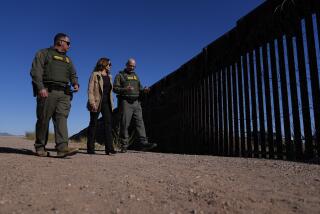Add Staff to Ease Backup at Mexican Border, Panel Told
SAN DIEGO — Stricter safeguards have made the U.S.-Mexico border safer since Sept. 11, but the federal government will have to spend more for new inspectors and facilities to ease traffic jams, U.S. border officials said at a congressional hearing here Thursday.
U.S. Customs Service Commissioner Robert C. Bonner, however, touring the San Diego area to make his own assessment of customs needs, said at a news conference that most resources should go to strengthening security along the border with Canada and at major U.S. seaports.
Bonner said some new agents are needed at California border stations, but he noted that wait times in San Diego have begun to return to pre-Sept. 11 levels because agents are working longer hours.
A congressional subcommittee heard the case for speeding commerce across the border, and also was told of a significant drop in the number of undocumented immigrants trying to cross the border since Sept. 11.
Arrests of undocumented immigrants have fallen dramatically since border inspectors began stepped-up searches of cars and more rigorous document checks, a sign that far fewer people are trying to cross illegally, authorities say. The searches, meanwhile, have yielded more drug seizures.
“We are working longer and harder,” said Rex Applegate, a customs field operations official.
Adele J. Fasano, director of the Immigration and Naturalization Service office in San Diego, said immigration fraud cases at ports of entry have fallen by more than half. “There have been significant effects of heightened border security,” she said.
The hearing was held by a House subcommittee on criminal justice and is one of a series along the Southwest and northern borders.
The panel was represented by its chairman, Rep. Mark Souder, an Indiana Republican. He was joined by Rep. Bob Filner (D-San Diego), who has sought emergency economic aid for U.S. communities on the border that have suffered lost sales due to crossing delays.
Several business leaders said they support tighter terrorism controls. They asked Congress, however, to send more inspectors to cut waiting times, which grew to up to eight hours after the terrorist attacks but have fallen to below an hour, on average.
“We need to act and we need to do it quickly,” said Viviana Ibanez of the San Diego Regional Chamber of Commerce.
Fasano said an analysis of staffing needs indicated it would take 300 more INS inspectors--a 50% increase--to fully cover California’s six ports of entry.
The border officials also urged Congress to improve pay for inspectors and agents to prevent high turnover.
William T. Veal, chief agent for the Border Patrol in San Diego, said his agents are leaving for better-paying law enforcement agencies in California. Last year, San Diego lost 282 agents from a force of 2,200, mostly to other police jobs, he said. Base pay for new border agents is between $25,000 and $31,000.
Fasano also said the border crossing at San Ysidro, with 24 vehicle lanes and eight pedestrian lanes, must be expanded to accommodate traffic from Tijuana. In 2000, 39 million people entered at San Ysidro, the nation’s busiest entrance point.
After Sept. 11, border officials imposed the most stringent checks in years. Inspectors began checking under the hoods and inside the trunks of far more vehicles than usual. Immigration officials also began conducting instant background checks on those crossing on foot. Everyone entering now is required to carry photo identification.
Those steps, plus increased vigilance by Border Patrol agents outside the official ports, have been accompanied by a huge drop in illegal crossing attempts.
Since Oct. 1, arrests of undocumented migrants by Border Patrol agents along 66 miles in San Diego have fallen by nearly 40%--to about 18,000--compared to the same period a year earlier, authorities said. The decline mirrors a trend along the 2,000-mile border, where arrests since Oct. 1 are down by 45% from a year earlier. The drop is especially significant because arrest levels last year were much lower than in previous years.
Arrests at San Diego’s three ports of entry also have fallen, from a monthly average of 4,150 to fewer than 1,000, since Oct. 1, the start of the federal fiscal year. Instances of immigrants smuggled inside car trunks and hidden compartments have all but disappeared. Bonner’s visit to San Diego on Thursday was coincidental to the congressional hearing.
“We need to look at the southern border,” Bonner said. “There will be some additional staffing here. But the large, significant amount of new resources is going to go to the north and our ports. The northern border with Canada has been much more chronically understaffed.”
Bonner said the customs budget is being increased by $400 million as a result of anti-terrorism concerns.
*
Times staff writer William Overend contributed to this report.
More to Read
Sign up for Essential California
The most important California stories and recommendations in your inbox every morning.
You may occasionally receive promotional content from the Los Angeles Times.










